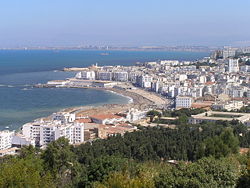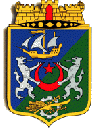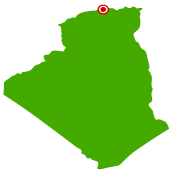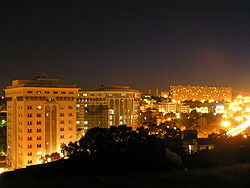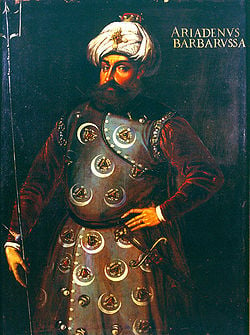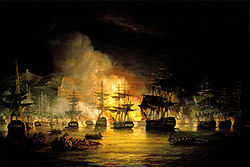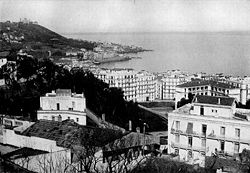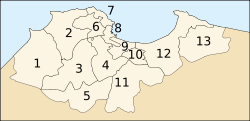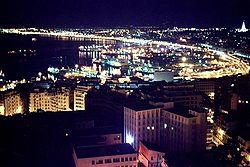Algiers
| Algiers | |||
| Algiers' coast. | |||
|
|||
| Nickname: Algiers the White, Al-Bahjah | |||
| Location of Algiers within Algeria | |||
| Coordinates: 36°42′N 3°13′E | |||
|---|---|---|---|
| Country | Algeria | ||
| Wilaya | Algiers Province | ||
| Re-founded | AD 944 | ||
| Government | |||
| - Wali (Governor) | Mohamed Kebir Addou | ||
| Population (2005) | |||
| - City | 1,519,570 | ||
| - Urban | 2,029,936 | ||
| - Metro | 3,518,083 | ||
| Time zone | CET (UTC+1) | ||
| Postal codes | 16000-16132 | ||
Algiers (Arabic: الجزائر, Standard Arabic: Al Jaza'ir IPA: [ɛlʤɛˈzɛːʔir], Algerian Arabic: Dzayer ([dzæjer] (From Berber pronunciation), Berber: File:Algeria tifinagh.JPG, Ledzayer [ldzæjər], French: Alger [ɑlʒe]) is the capital and largest city of Algeria and the second in North Africa behind Casablanca in Morocco.
Nicknamed El-Bahdja (البهجة) or Alger la Blanche ("Algiers the White") for the glistening white amphitheatre of buildings seen rising up from the sea, it is located in northern Algeria, on the west side of the Bay of Algiers, on the Mediterranean Sea.
Geography
The city name is derived from the Arabic word al-jazā’ir, which translates as the islands, referring to the four islands which lay off the city's coast until becoming part of the mainland in 1525. Al-jazā’ir is itself a truncated form of the city's older name jazā’ir banī mazghannā, "the islands of (the tribe) Bani Mazghanna", used by early medieval geographers such as al-Idrisi and Yaqut al-Hamawi.
Algiers extends for 10 miles (16km) along the Bay of Algiers. The modern part of the city is built on the level ground by the seashore and the old part, the ancient city of the deys, climbs the steep hill behind the modern town and is crowned by the casbah or citadel, Template:Ft to m/1mosyes above the sea. The casbah and the two quays form a triangle.
The coast has a pleasant climate, with winter temperatures from 50°F to 54°F (10°C to 12°C) and summer temperatures from 75°F to 79°F (24°C to 26°C). Rainfall in this region is abundant - 15 to 27 inches per year.
The Oued El Harrach river, which flows through Algiers, is very polluted despite the installation of a waste water treatment facility nearby. Mercury levels present are 30 times those accepted around the world.
As a result of irregular rainfall to aging infrastructure that can cause immense losses of water, fresh water is a luxury most people enjoy only two to three hours a day in the capital city of Algiers. The city is the location of the Hamma project, which is intended as Africa’s largest seawater desalination plant, with a goal of supplying 53 million U.S. gallons (200,000 cubic meters ) of potable water a day.
Districts include:
- The Casbah, which is founded on the ruins of old Icosium. It is a small city which, built on a hill, goes down towards the sea, divided in two: the High city and the Low city. Located there are the Ketchaoua mosque (built in 1794), mosque el Djedid (1660, at the time of Turkish regency), mosque El Kébir (built by almoravide Youssef Ibn Tachfin and rebuilt later in 1794), mosque Ali Betchnin (Raïs, 1623), Dar Aziza, palate of Jénina. There are labyrinths of lanes and picturesque houses.
- Bab El-Wadi, famous for its place “the three clocks” and for its “market Triplet”, and contains workshops.
- Edge of sea, which was built from 1840, to form an elegant walk bordered with arcades, including the Che Guevara boulevard.
- The Kouba, which developed under French colonial, and is made up mainly of houses, villas and buildings not exceeding five floors.
- El Harrach, which is named after the river which crosses this district.
- The communes of Hydra, Ben Aknoun, El-Biar and Bouzareah are the location of foreign embassies, of many ministries and university centers.
- The street Didouche Mourade, which extends from the Grande Post office to the Heights of Algiers, has smart stores and restaurants, and is regarded as the heart of the capital.
History
Phoenicians founded a commercial outpost called Ikosim, around 1200 B.C.E., on what is now the marine quarter of the Algiers. Carthaginians and the Romans called it Icosium. The city became part of the Roman Empire after the Punic Wars in 146 B.C.E. Vandals overran the city in the middle of the fifth century. Next, it was ruled by the Byzantines, who were in turn ousted in 650 by Arabs.
In 944, Buluggin ibn Ziri, the founder of the Berber Zirid-Senhaja dynasty, revived the city into a centre of commerce in the Mediterranean under its present name. During the next three centuries the city was controlled by various European, Arabian, and Berber warlords.
In the 13th century, Algiers came under the dominion of the Abd-el-Wadid sultans of Tlemcen. The city retained a large measure of independence under amirs of its own, Oran being the chief seaport of the Abd-el-Wahid. The islet in front of the harbour, subsequently known as the Penon, had been occupied by the Spaniards as early as 1302. Thereafter, a considerable trade grew up between Algiers and Spain.
In the early 16th century, many Moors expelled from Spain sought asylum in Algiers. In response to attacks from Algiers on Spanish seaborne commerce, Spain in 1510 fortified the offshore island of Peñon in the Bay of Algiers.
In 1516, the amir of Algiers, Selim b. Teumi, invited the corsair brothers Aruj and Khair ad-Din Barbarossa to expel the Spaniards. Aruj came to Algiers, caused Selim to be assassinated, and seized the town. Arouj was killed in battle against the Spaniards at Tlemcen in 1518. Khair ad-Din succeeded him, and placed Algiers under the Ottoman Empire.
Algiers from this time became the main base of the Barbary pirates that attacked shipping in the western Mediterranean and engaged in slave raids as far north as Cornwall. European powers sent numerous expeditions against the pirates.
In October 1541, the king of Spain and Holy Roman Emperor Charles V sought to capture the city, but a storm destroyed a great number of his ships, and his army was defeated. The United States fought two wars (the First and Second Barbary Wars) over Algiers' attacks on shipping. In 1816, the city was bombarded by a British squadron under Lord Exmouth (a descendant of Thomas Pellew, taken in an Algerian slave raid in 1715), assisted by Dutch men-of-war.
On July 4, 1827, on the pretext of an affront to the French consul — whom the dey had hit with a fly-whisk when he said the French government was not prepared to pay its large outstanding debts to two Algerian Jewish merchants — a French army under General de Bourmont attacked the city, which capitulated the following day. The French made Algiers a control center for their colonial empire in North and West Africa.
During World War II, Algiers became the headquarters of Allied forces in North Africa and was for a time the location of the Free French government of General de Gaulle.
Algiers plays also a decisive part during the War of Algeria (1954-1962), in particular during the Battle of Algiers. Up to 1.5 million Algerians died in the bloody independence struggle. Algeria became independent on July 5, 1962.
In October 1988, one year before the fall of the Berlin Wall, Algiers was the theatre of demonstrations to end of the single party system. Harsh repression left more than 300 dead.
Algiers has been the target of Islamic terrorist attacks. On April 11, 2007, the palace of the Prime Minister and the Minister of Interior Department, and a police station were bombed. Islamic terrorist group Al-Qaïda claimed responsibility. On December 11 of that year, twin blasts struck UN offices and a Government building in Algiers, causing dozens of deaths.
Since independence, despite losing its entire European population, the city has expanded massively. It now has about three million inhabitants, or 10 percent of Algeria's population — and its suburbs now cover most of the surrounding Metidja plain.
Administration
Algiers is a province in the 48-province People's Democratic Republic of Algeria. It is named after its capital, Algiers, which is also the national capital. It is adopted from the old French département of Algiers.
It is divided into 13 districts and 57 municipalities. The districts are, according to official numbering: Zéralda 1, Chéraga 2, Draria 3, Birtouta 4, Bir Mourad Raïs 5, Bouzaréah 6, Bab El Oued 7, Hussein Dey 8, Sidi M'Hamed 9, El Harrach 10, Baraki 11, Dar El Beïda 12, and Rouïba 13.
Economy
Algiers is an important economic, commercial financial pole, in particular with a stock exchange recording an annual capitalization of 60 billion euros. The port of Algiers is also the most important of West Africa.
xxxfrom more recent versionxxx Algiers is an important economic, commercial and financial center, with in particular a stock exchange with a capitalisation of 60 billion euros. The port of Algiers is also the most important of West Africa. The city has the highest cost of living of any city in North Africa, as well as the 50th highest worldwide, as of March 2007, having gained one position comparet to the previous year. [1] Mohamed Ben Ali El Abbar, president of the Council d administration of the emirate group EMAAR, presented five "megaprojects" to Algerian President Abdelaziz Bouteflika, during a ceremony which took place Saturday, July 15 with the Palate of the People of Algiers. The projects will transform the city of Algiers and its surroundings by equipping them with a retail area, and restoration and leisure facilities. The first project will concentrate on the reorganization and the development of the infrastructures of the railway station "Aga" located in the downtown area. Ultramodern, the station, intended to accommodate more than 80.000 passengers per day, will become a center of circulation in the heart of the grid system, surrounded by commercial offices and buildings and hotels intended for travelers in transit. A shopping centre and three high-rise office buildings rising with the top of the commercial zone will accompany the project. The second project will relate to the bay of Algiers and aims to revitalize the sea front. The development of the 44 km (27 mi) sea front will include marinas, channels, luxury hotels, offices, apartments of great standing, luxury stores and leisure amenities. A crescent-shaped peninsula will be set up on the open sea. The project of the bay of Algiers will also comprise six small islands, of which four of round form, connected to each other by bridges and marinas and will include tourist and residential complexes. The third project will relate to restructuring an area of Algiers, qualified by the originators of the project of "city of wellness". El Abbar indicated to the journalists that the complex would be "agréable for all those which will want to combine tourism and wellbeing or tourism and relaxation". The complex will include a university, a research center and a medical centre. It should also include a hospital complex, a care, centre, a hotel zone, an urban centre and a thermal spa with villas and apartments. The university will include a medical school and a school for care male nurses which will be able to accommodate 500 students. The university campus will have the possibility of seeing setting up broad ranges of buildings of research laboratories and residences. Another project relates to technological implantation of a campus in Sidi Abdellah, 25 km (16 mi) south-east from Algiers. This 90 hectares (222 acres) site will include shopping centres, residential zones with high standard apartments and a golf course surrounded by villas and hotels. Two other residential zones, including 1.800 apartments and 40 high standard villas, will be built on the surrounding hills. The fifth project is that of the tourist complex Colonel Abbès, which will be located 25 km (16 mi) west from Algiers. This complex will include several retail zones, meetingplaces, and residential zones composed of apartments and villas with views of the sea.
Tourist Installations
To some 20 km in the west of Algiers seaside resorts are such as Sidi Fredj (ex-Sidi Ferruch), Palm Beach, Douaouda, Zéralda, the Club of the Pines (residence of State); one will find there complexes tourist, Algerian and different restaurants, souvenir shops, supervised beaches, etc the city is also equipped with important hotel complexes such as the hotel Hilton, El-Aurassi or El Djazair. Algiers also obtained the first watery park of the country. Located at ten minutes of the city while going towards the East, Kiffan Club extends on a surface from 2 hectares. Large adult basin, several basins children as well as large toboggans, the site includes/understands several points of restoration. With dimensions is the Karting Escape, who opened his doors in 2005, with a long track 700 meters and having three categories different of karts. Aquafortland comes to supplement this decoration with a ludic swimming pool spread out over 1,5 hectares, and having all the conveniences necessary for the wellbeing of the customer. The tourism of Algiers be in full rise but be not also develop than that of large city of Morocco or of Tunisia.
Transports
- the ETUSA (urban and suburban Haulage company of Algiers) has bus as of the mégabus since 2006 which serves the capital like its suburbs. 54 lines are currently operational and the service is ensured of 5h30 0h45.
- SNTF (national Company of the rail-bound transports) operates on lines connecting the capital to the of Algiers suburbs starting from the of Algiers stations.
- Houari Boumedienne Airport managed by EGSA (Undertaken management of the airport services) at 20 kms is located. The majority of the airline companies had suspended their service road towards Algiers since the taking of hostages on December 24, 1994 of the flight Air France Flight AF 8969 but the majority returned since. The airport serves the majority of the European cities, it West Africa, it the Middle East and soon it North America with the startup as of June 2007 of the direct flight Algiers Montreal. Inaugurated on July 5, 2006 new an air terminal International is from now on in service. Its very modern infrastructures can better manage the flow of the international traffics. The company Airports of Paris, gére this news large installation.
Demographics
According to the 1998 census the population of the city proper was 1,519,570, for the urban area was 2,135,630, for the metropolitan area 3,518,083, and for Algiers Province as a whole 5,723,749 (2006). So the urban area of Greater Algiers is the largest one in the Maghreb[2].
The ethnic distribution is 59% arabs, 38% kabyle and 3% "foreigners", most of them are from china, vietnam and mali.
| Year | Population |
|---|---|
| 1977 (Census) | 1,353,826 |
| 1987 (Census) | 1,507,241 |
| 1998 (Census) | 1,519,570 |
| 2007 (Estimate) | 2,072,993 |
Culture
Local architecture
There are many public buildings of interest, including the whole Kasbah quarter, Martyrs Square (Sahat ech-Chouhada ساحة الشهداء), the government offices (formerly the British consulate), the "Grand", "New", and Ketchaoua Mosques, the Roman Catholic cathedral of Notre Dame d'Afrique, the Bardo Museum (a former Turkish mansion), the old Bibliotheque Nationale d'Alger — a Turkish palace built in 1799–1800 — and the new National Library, built in a style reminiscent of the British Library.
The main building in the Kasbah was begun in 1516 on the site of an older building, and served as the palace of the deys until the French conquest. A road has been cut through the centre of the building, the mosque turned into barracks, and the hall of audience allowed to fall into ruin. There still remain a minaret and some marble arches and columns. Traces exist of the vaults in which were stored the treasures of the dey. The Grand Mosque (Jamaa-el-Kebir الجامع الكبير) is traditionally said to be the oldest mosque in Algiers. The pulpit (minbar منبر) bears an inscription showing that the building existed in 1018. The minaret was built by Abu Tachfin, sultan of Tlemcen, in 1324. The interior of the mosque is square and is divided into aisles by columns joined by Moorish arches.
The New Mosque (Jamaa-el-Jedid الجامع الجديد), dating from the 17th century, is in the form of a Greek cross, surmounted by a large white cupola, with four small cupolas at the corners. The minaret is 90 feet (27 m) high. The interior resembles that of the Grand Mosque.
The church of the Holy Trinity (built in 1870) stands at the southern end of the rue d'Isly near the site of the demolished Fort Bab Azoun باب عزون. The interior is richly decorated with various coloured marbles. Many of these marbles contain memorial inscriptions relating to the English residents (voluntary and involuntary) of Algiers from the time of John Tipton, British consul in 1580. One tablet records that in 1631 two Algerine pirate crews landed in Ireland, sacked Baltimore, and carried off its inhabitants to slavery; another recalls the romantic escape of Ida M’Donnell, daughter of Admiral Ulric, consul-general of Denmark, and wife of the British consul. When Lord Exmouth was about to bombard the city in 1816, the British consul was thrown into prison and loaded with chains. Mrs M’Donnell — who was but sixteen — escaped to the British fleet disguised as a midshipman, carrying a basket of vegetables in which her baby was hidden. (Mrs M’Donnell subsequently married the duc de Talleyrand-Perigord and died at Florence in 1880). Among later residents commemorated is Edward Lloyd, who was the first person to show the value of esparto grass for the manufacture of paper, and thus started an industry which is one of the most important in Algeria.
The Ketchaoua mosque (Djamaa Ketchaoua جامع كتشاوة), at the foot of the Casbah, was before independence in 1962 the cathedral of St Philippe, itself made in 1845 from a mosque dating from 1612. The principal entrance, reached by a flight of 23 steps, is ornamented with a portico supported by four black-veined marble columns. The roof of the nave is of Moorish plaster work. It rests on a series of arcades supported by white marble columns. Several of these columns belonged to the original mosque. In one of the chapels was a tomb containing the bones of San Geronimo. The building seems a curious blend of Moorish and Byzantine styles.
Algiers possesses a college with schools of law, medicine, science and letters. The college buildings are large and handsome. The Bardo museum holds some of the ancient sculptures and mosaics discovered in Algeria, together with medals and Algerian money. The port of Algiers is sheltered from all winds. There are two harbours, both artificial — the old or northern harbour and the southern or Agha harbour. The northern harbour covers an area of 235 acres (95 ha). An opening in the south jetty affords an entrance into Agha harbour, constructed in Agha Bay. Agha harbour has also an independent entrance on its southern side.
The inner harbour was begun in 1518 by Khair-ad-Din Barbarossa (see History, below), who, to accommodate his pirate vessels, caused the island on which was Fort Penon to be connected with the mainland by a mole. The lighthouse which occupies the site of Fort Penon was built in 1544.
Algiers was a walled city from the time of the deys until the close of the 19th century. The French, after their occupation of the city (1830), built a rampart, parapet and ditch, with two terminal forts, Bab Azoun باب عزون to the south and Bab-el-Oued باب الواد to the north. The forts and part of the ramparts were demolished at the beginning of the 20th century, when a line of forts occupying the heights of Bouzareah بوزريعة (at an elevation of 1,300 feet (396 m) above the sea) took their place.
Notre-Dame d'Afrique, a church built (1858–1872) in a mixture of the Roman and Byzantine styles, is conspicuously situated, overlooking the sea, on the shoulder of the Bouzareah hills, 2 miles (3.2 km) to the north of the city. Above the altar is a statue of the Virgin depicted as a black woman. The church also contains a solid silver statue of the archangel Michael, belonging to the confraternity of Neapolitan fishermen.
Villa Abd-el-Tif, former residence of the dey, was used during the French period, to accommodate French artists, chiefly painters, and winners of the Abd-el-Tif prize, among whom Maurice Boitel, for a while of two years. Nowadays, Algerian artists are back in the villa's studios.
= Monuments \
- Houbel.JPG
The Monument of the Martyrs (Maquam E’chahid)
- Notre-dame-afrique.jpg
Notre Dame d'Afrique
- Notre Dame d'Afrique , accessible by one cable car, is one of its most outstanding monuments: located in the district of Z' will ghara, the basilica was built around 1858.
- Monument of the Martyrs ( Maquam E' chahid ): Set up with the site of the war memorial of the second world war natives of Algeria, destroyed by the Algerian government, high of 90 meters and overhanging Algiers, this monument was built by a Canadian company in 1984, and is composed of three palms resting on a vast esplanade where the “eternal flame is”. It is dedicated to the memory of the combatants of guerre of independence of the country.
- Place of the Emir Abdelkader (ex-place Bugeaud): in memory of the famous emir Abd El-Kader, resistant during conquête of Algeria.
- the Large Post office (1910, by Voinot and Tondoire): construction of the néo-Moorish type which is in full centre town of Algiers.
- Garden of Test ( El-Hamma ): located has Is of Algiers, it extends on a surface from 80 hectares. It was created in 1832 by A. Hardy. Exotic plants and gardens there are found.
- Villa Abd-el-Hair , with the top of the Garden of test, one of the old residences of the dey, where until 1962, were placed the artists prizes winner of Price Abd-el-Hair, and in particular Maurice Boitel and Andre Hamburg.
- Citadel .
- Riadh El-Feth (shopping centre and art gallery).
- Large Mosque of Algiers (This mosque became the Saint-Philippe cathedral during colonization before becoming again a mosque).
- National Library , is in the district of El HAMMA.Elle has an architecture modèrne and marries the decoration perfectly.
Quinquennial projects of the wilaya of Algiers
- To make up the enormous deficit which the town of Algiers as regards transport knows, this one will be equipped with one tram which will connect it downtown area to Dergana (operational in 2009), of a line of subway Tafourah-Large Harrach Post office-El (operational in 2008) and several lines RER Algiers-Aga-Thenia, Algiers-Aga-Elafroun, Algiers-Aga-Zeralda. Be added to all this the reorganization of Etusa (Haulage company Urbain and Suburbain of Algiers), the realization of three new cable car S from here 2009, the rehabilitation of four what exists as well as the refitting of roadway system. It is also a question of the restoration of the station of Algiers (Aga) to accommodate the future line High-speed rail Annaba-Algiers-Oran.
- In addition, in response to the increase always increasing in the automobile park, and parallel to the installation of way S and roundabouts, of échangeurs and of the sections of motorway were built right now, and others are in the course of construction in order to improve the traffic in the metropolis.
- One of the most ambitious projects is the installation of bay of Algiers which will include/understand a mall of two kilometers, it Marriots hotel Algiers, spaces of relaxation, a business district a with shopping centre, and finally, the future large one mosque of Algiers. This mosque will be the second largest in the world with a capacity of reception of more than 80,000 faithful. A school - at the same time école and school of science the S - y will be attached, bordered by parks.
- Construction of two seaside resorts on the of Algiers littoral.
- Park of the high winds which is located at the west of Algiers: it will be largest in the world; many species of trees and plants will be planted there.
- The new town of Sidi Abdellah which will include/understand a technological pole and of research, like residences.
- Within the framework of the project of a million residences that the state launched, Algiers will benefit from additional residences to the program of 2001 and 2004, in order to fight effectively against the current housing shortage.
Sports
Algiers is the largest sporting pole of Algeria. Cash clubs in the whole of the disciplines, and which conquered many national and international titles, it also counts an enormous sporting complex (Complex of OCO - Mohamed Boudiaf), which gathers the Olympic stage of July 5 (of a capacity of 80,000 places), a stage annexes for athletics, an Olympic swimming pool, a room multisports (the Cupola), a golf 18 holes, and several courts of tennis.
Algiers already accommodated the following sporting events (not-exhaustive list):
- Mediterranean Plays 1975.
- Panafrican Plays 1978.
- Cut of Africa of the Nations of Association football 1990.
- Cut of Africa of the Nations of Team Handball 2001.
- Jeux plays panarabes 2004.
- Cross-country race from Africa of the Nations of Basketball 2005.
- World cup juniors by Volleyball 2005.
- African's plays 2007
Clubs of football
Principal clubs of association football of the city (having already evolved/moved in Division 1):
- MC Algiers
- USM Algiers
- CR Belouizdad
- NA Hussein Dey
- Paradou AC
- USM El Harrach
- RC Kouba
- OMR El Anasser
- DNC Algiers
Films about Algiers
- La Battle of Algiers, 1966, realized by Gillo Pontecorvo
- Bab City El-Wadi, 1994, carried out by Merzak Allouache over the black period of the Nineties
- Viva aldjery, 2003, realized by Nadir Moknèche. With Biyouna and Lubna Azabal
- Bab el Web, 2004, carried out by Merzak Allouache with Samy Naceri, Julie Gayet, Faudel
- It was once in the wadi, 2005, realized by Djamel Bensalah.
- Beur, White, Red, 2005, realized by Mahmoud Zemmouri.
ReferencesISBN links support NWE through referral fees
- This article incorporates text from the Encyclopædia Britannica Eleventh Edition, a publication now in the public domain.
See also
- List of Pasha and Dey of Algiers
External links
- Algiers World Fact Book, accessed June 23, 2008.
- The best of Algiers
- Photos of Algiers
- Historic images of Algiers
- Map of Algiers
- Algermag: Algiers is cool
-
- Mapping from Multimap or GlobalGuide or Google Maps
- Satellite image from WikiMapia
- Mapping from OpenStreetMap
| |||||
Credits
New World Encyclopedia writers and editors rewrote and completed the Wikipedia article in accordance with New World Encyclopedia standards. This article abides by terms of the Creative Commons CC-by-sa 3.0 License (CC-by-sa), which may be used and disseminated with proper attribution. Credit is due under the terms of this license that can reference both the New World Encyclopedia contributors and the selfless volunteer contributors of the Wikimedia Foundation. To cite this article click here for a list of acceptable citing formats.The history of earlier contributions by wikipedians is accessible to researchers here:
The history of this article since it was imported to New World Encyclopedia:
Note: Some restrictions may apply to use of individual images which are separately licensed.
- ↑ MERCER Human Ressources Consulting - Moscow tops Mercer's cost of living list; London is close behind
- ↑ (English) - http://www.citypopulation.de/ Thomas Brinkhoff : The Principal Agglomerations of the World.
